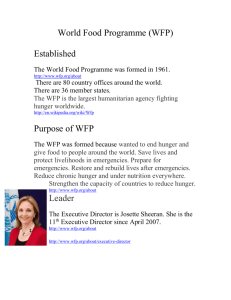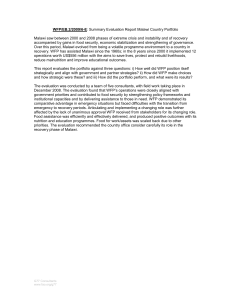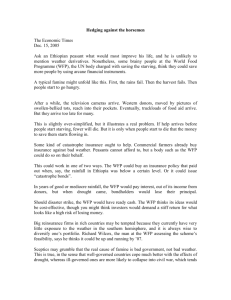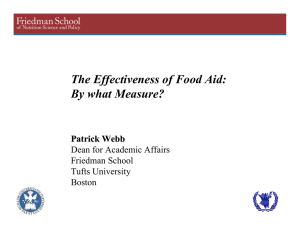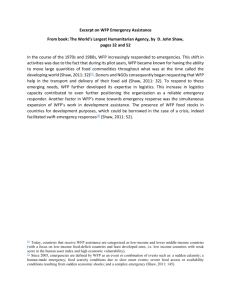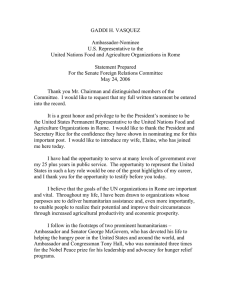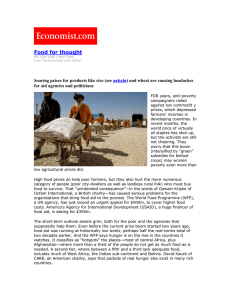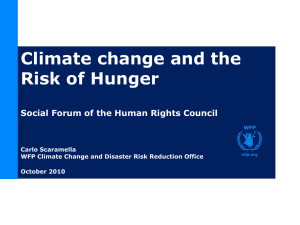Engagement in Poverty Reduction Strategies
advertisement
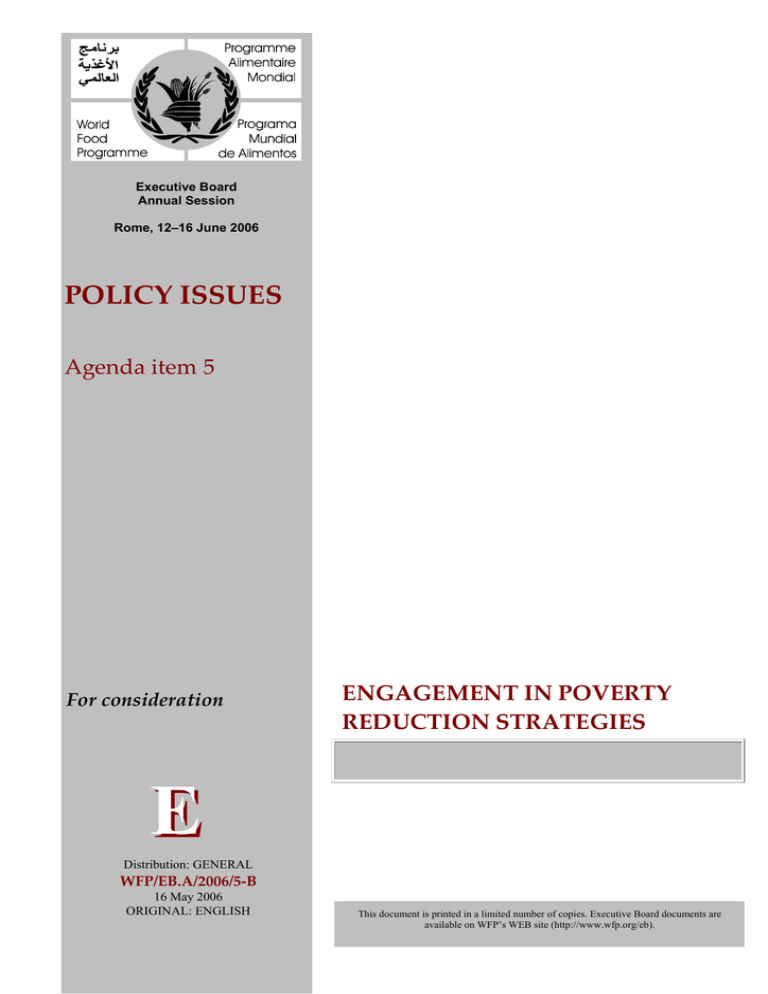
Executive Board
Annual Session
Rome, 12–16 June 2006
E
Distribution: GENERAL
16 May 2006
ORIGINAL: ENGLISH
This document is printed in a limited number of copies. Executive Board documents are
available on WFP’s WEB site (http://www.wfp.org/eb).
2
WFP/EB.A/2006/5-B
This document is submitted to the Executive Board for consideration.
The Secretariat invites members of the Board who may have questions of a technical
nature with regard to this document to contact the WFP staff focal points indicated
below, preferably well in advance of the Board’s meeting.
Director, PDP:
Mr S. Samkange
tel.: 066513-2767
Senior Policy Adviser, PDP:
Mr S. Tejno
tel.: 066513-3545
Should you have any questions regarding matters of dispatch of documentation for the
Executive Board, please contact Ms C. Panlilio, Administrative Assistant, Conference
Servicing Unit (tel.: 066513-2645).
WFP/EB.A/2006/5-B
The articulation of a country’s Poverty-Reduction Strategy is rapidly becoming the process
around which the government, donors and United Nations agencies coalesce to ensure a
coherent, effective and targeted effort at poverty reduction and the achievement of the
Millennium Development Goals.
By engaging in policy dialogues, WFP can provide government and other stakeholders with
vital information about the poorest of the poor so that they can make Poverty-Reduction
Strategies that are better informed.
When engaging in the Poverty-Reduction Strategy process, WFP must deploy its own
strategic and comparative advantages. WFP should draw on its capacities and experience in
addressing food insecurity and malnutrition as well as in supporting emergency preparedness
and assistance. WFP should also deploy its own knowledge of local circumstances,
vulnerabilities and development options as well as its operational capacity to address
emergencies.
3
4
WFP/EB.A/2006/5-B
The Board recommends that WFP:
engage in the Poverty-Reduction Strategy process to ensure due attention to
hunger reduction;
support governments in hunger-reduction programmes through capacity-building;
support harmonization and alignment through the Poverty-Reduction Strategy
process by engaging in joint programming and with United Nations country
teams;
prepare detailed guidance on engagement in Poverty-Reduction Strategy
processes; and
consider how best to build staff capacity and support country offices, in line with
its mandate and Strategic Objectives, and taking account of competing resource
needs and operational priorities.
1.
The articulation of a country’s Poverty Reduction Strategy (PRS) is rapidly becoming
the process around which the government, donors and United Nations agencies coalesce to
ensure a coherent, effective, and targeted effort at poverty reduction and the achievement
of the Millennium Development Goals (MDGs). Where this process becomes an integral
part of the country’s own development planning, it creates a natural vehicle for the
United Nations and donors to align and harmonize their activities to increase effectiveness
and efficiency in addressing poverty and related issues.
2.
Efforts are currently under way to harmonize and simplify aid processes to allow greater
efficiency as outlined in the Rome and Paris Declarations.1 The desire to increase national
ownership of the development process and to define the roles of donors and partners more
clearly are at the core of this evolution. A clear link can be seen between efforts to ensure
that PRSs are an accurate reflection of national priorities and donors’ and partners’ efforts
to identify a strategic framework for cooperation. At the implementation level, both
governments and donors are increasingly using sector-wide approaches (SWAPs) to ensure
a commonly used instrument for implementation. Within the spirit of the Rome and Paris
Declarations and as part of the Secretary-General’s reform efforts, the United Nations
agencies, funds and programmes are beginning to define their own unique roles in this
process — a process that has commenced, but is far from complete.
3.
As a result, it is important that WFP be properly equipped to participate in the national
PRS processes and to assist countries where required to articulate focused
hunger-reduction strategies as part of efforts to reduce overall poverty.
*
This is a draft decision. For the final decision adopted by the Board, please refer to the Decisions and
Recommendations (document WFP/EB.A/2006/16) issued at the end of the session.
1
Paris Declaration on Aid Effectiveness and Rome Declaration on Harmonization.
WFP/EB.A/2006/5-B
4.
5
This paper reflects on the opportunities and the challenges for WFP engagement in the
PRS process and associated programmes such as SWAPs.
! "#$%&'()! $* $+,),!- ,( +,",('&,(.
/(.!%
5.
Food insecurity and malnutrition are key dimensions of poverty, as reflected in the
priority assigned to hunger in MDG 1: evidence shows that while growing national income
levels can contribute to reducing food insecurity, reductions in hunger and improvements
in nutritional status frequently lag behind the realized reductions in relative poverty. For
instance, evidence has suggested that only half of the documented reduction in child
undernutrition across developing countries can be attributed to income growth. Eliminating
hunger is a necessary prerequisite for reducing poverty since hunger impairs people’s
ability to overcome poverty given its negative impacts on health, education, learning, and
labour productivity. Implementing well-defined food- and nutrition-security strategies
within the overall PRS can ensure that progress in reducing hunger will not only keep pace
with reducing poverty, but also provide a foundation for accelerated rates of poverty
reduction.
6.
Traditionally, food-security and nutrition programmes have received low priority both
from governments and development partners for four main reasons:2
i) Most undernourished families are poor and generally live in rural areas which are
often remote and hence they have little voice.
ii) Governments and development partners have been slow to recognize the costs of
hunger and malnutrition, especially the fact that hunger is impeding progress not only
toward MDG 1, but toward a number of other MDGs.
iii) There is little demand for nutrition services from communities, because moderate and
mild malnutrition are not easily detected, particularly malnutrition due to poor dietary
quality, such as vitamin A, iron and iodine deficiencies.
iv) Because multiple organizational and institutional stakeholders are involved in
food-security and nutrition issues, responsibility for addressing the issue is often
diffused or diluted by governments and within donor organizations themselves.
7.
2
Hunger reduction is a theme as opposed to a sector. Because country financing is often
allocated to sectors, cross-sectoral interventions require strong coordination or an
institutional lead in order to implement national strategies. Significant progress on food
and nutrition security is unlikely without coordinated, focused and increased action — thus
compromising the ability to achieve all or most of the MDGs. The complementary
mandates of WFP, the Food and Agriculture Organization of the United Nations (FAO)
and the United Nations Children’s Fund (UNICEF) include providing guidance and
experience on strategies and policies for reducing food insecurity and undernutrition and
supporting capacity development in related areas.
World Bank. 2006. Repositioning Nutrition as Central to Development – A Strategy for Large-Scale Action.
Washington DC.
6
WFP/EB.A/2006/5-B
')0.%$/(1
8.
In 1999, following considerable stakeholder dialogue and debate, the donor community
embraced the need for debt relief. However, donors were concerned that resources freed up
from debt relief should be focused on poverty reduction. The Poverty Reduction Strategy
Paper (PRSP) designed by the World Bank and the International Monetary Fund (IMF)
was to serve as a framework document for governments to use funds freed by external debt
relief under the Heavily Indebted Poor Country (HIPC) initiative.
9.
The major features of the PRSP were defined by the World Bank and IMF to comprise:
an analytical and comprehensive framework integrating macro-economic, structural,
sectoral and social considerations; and
a set of poverty-reduction measures and policies with monitorable indicators of
progress.
10.
The papers were to be owned nationally and developed through a participatory process
with a results-orientated approach. They now also increasingly reflect the MDGs.
Although the papers focused on an initial three-year time frame, their conception was
envisaged within a longer-term horizon. The PRS process was to identify the main
characteristics of the poor in a country — who, where and why — and formulate a
results-oriented strategy and a prioritized action plan within available resources to secure
measurable reductions in poverty. A participatory process was to be employed in order to
secure a comprehensive, cohesive and inclusive strategy in addition to augmenting national
ownership. While early PRSPs indicated varying degrees of government ownership and
stakeholder engagement, revisions to the process have attempted to foster greater national
ownership by encouraging the integration of the process into governments’ national
development planning processes.
11.
Recognizing that the process is as important as the product, the emphasis has shifted
from the paper to the process. This has resulted in, among other things, local names for the
resulting document and the use of the term “Poverty Reduction Strategy process” as
opposed to “poverty reduction strategy paper”. The PRS is now being approved by the
national governments. So, while the World Bank and IMF no longer formally approve the
resulting strategy, a strategy that lacks the support of the broader development community
in a country is unlikely to receive widespread funding commitments.
12.
There is also a role for a PRS framework in conflict-affected countries or fragile states.
As conflict-affected countries are often characterized by volatility and rapidly changing
circumstances, while at the same time facing serious capacity constraints within
governments or other representative bodies, the PRS process and strategy must be
structured to take account of these needs. As a result, their design and implementation
should allow the countries to respond relatively quickly to changing situations; to be
flexible in their design and implementation; and produce alternative options when changes
render current measures irrelevant.
13.
To date, 60 countries have completed PRSs, of which ten are interim PRSs. WFP has
country offices in 45 of the 60 countries. The majority of current PRSs emanate from
Africa — many of the countries striving to meet criteria for debt relief under HIPC are in
the continent. However, the World Bank now encourages the development of similar
processes in order to obtain international development assistance. Therefore, many
WFP/EB.A/2006/5-B
7
countries, which are not part of the HIPC initiative, are now engaged in similar processes
and strategy preparation. The PRS is increasingly becoming a nationally preferred
framework rather than just a means for HIPC qualification.
14.
WFP is increasingly participating in this process in order to help countries incorporate
food insecurity and nutrition into the PRS, which are currently not well represented.
'%"$(,2'&,$(
15.
As a follow-up to the Paris Declaration, the United Nations Development Group
(UNDG), of which WFP is an EXCOM member, has developed an action plan
representing a commitment to addressing a number of urgent and challenging issues within
a new aid paradigm. The plan details the main principles of commitment:
i)
putting national development plans, such as the PRS, at the centre of United Nations
country programming;
ii) strengthening national capacities; and
iii) increasingly using and strengthening national systems.
16.
The plan includes alignment of programme cycles, both with regard to the
United Nations agencies but also with the PRS and SWAP processes; maximizing the
synergies between the Common Country Assessment (CCA)/United Nations Development
Assistance Framework (UNDAF) and national processes, including support for PRS and
SWAPs, as well as joint programming. Together with the United Nations Development
Programme (UNDP), the United Nations Population Fund and UNICEF, WFP has agreed
to:
major operational simplification;
a focus on national systems; and
reduced transaction costs.
17.
Harmonization and alignment are processes that require considerable initial resources,
and to some degree medium and longer-term resources. However, priority should be given
to a proactive participation in the move towards harmonization at the Headquarters,
regional and country levels in order for WFP to further its core mandate of hunger
reduction and humanitarian concerns.
!+'&,$(- ,# !&3!!(
4
'(1
18.
The United Nations country team (UNCT) guidance and instruments for programme
development and implementation are also relevant to the PRS process. According to
UNCT guidelines: “UNCT should participate in PRSP processes as a platform to advovate
a more holistic development approach linked to human rights”. Two of these instruments
— the CCA and UNDAF — are particularly applicable. The CCA is an analytical
assessment of a country’s development situation, strategies and needs; the UNDAF
provides a framework for harmonized United Nations programming of resources towards
goals agreed among all development partners under government leadership. As the
UNDAF is becoming increasingly aligned towards the achievement of national MDGs, it
can be seen as a roadmap showing how the United Nations has agreed with governments to
work towards poverty reduction in its broader sense.
19.
The CCA used to be a mandatory step in the preparation of the UNDAF and thus also
for individual country programmes, but UNCTs now have the option to proceed with a
8
WFP/EB.A/2006/5-B
CCA or use alternative analytical tools such as the PRS process. When a CCA is prepared
it represents consensus in the United Nations system on the current development
challenges facing the country and can serve as a useful tool in the PRS process, both as an
integrated element of the process and because it draws significantly on the analytical
capacity, neutrality and universality of the United Nations system.
20.
In cases where CCAs are not prepared, the benefits of using the PRS process in the
development of an UNDAF are evident. Taking the national PRS process as the basis for
establishing a United Nations assistance framework and therefore also individual or
common country programmes for the various agencies, funds and programmes ensures that
officially endorsed PRSs are taken as the point of departure for planning purposes.
21.
The UNDAF will often need to go further than what is possible or desirable in a PRS
process as the UNDAF forms the basis for operational plans and interventions, including
its contribution to the achievement of national MDGs.
22.
All new country programmes approved by the Board in 2004 and 2005 had a national
PRS as a guiding strategy and an UNDAF as a framework. In this context, it is important
to note that not only is WFP benefiting from participation in these common analytical and
planning activities, but also that the process might itself benefit from the analytical
capacity and extensive field knowledge of WFP.
'(2'(,' '(1 & !
5& !
0/0/&'
The Tanzania example demonstrates how the PRS can be used in the preparation of the
UNDAF. In addition to an independent joint strategic review of the United Nations system, the
Mkukuta was completed in 2005. On the basis of these and to ensure that the UNDAF was
fully aligned with the latter, the United Nations country management team decided not to
prepare a CCA, but to use the Mkukuta as a basis for the UNDAF. Six working groups that
addressed areas of concerns in the joint strategic review and the Mkukuta were established
initially for the new UNDAF — afterwards reduced to three4 — to ensure a more focused
United Nations response. WFP has assigned staff to participate in each group as appropriate.
Each working group prepared a problem-tree analysis identifying: (i) the highest level Mkukuta
broad goals; (ii) related UNDAF outcomes by the end of the cycle; (iii) country programme
outcomes; (iv) country programme outputs; (v) partners’ roles; and (vi) resource mobilization
targets.
The process is new to many WFP staff members who have never worked within an
UNDAF/PRS framework.5 While time consuming and not always directly relevant to WFP’s
immediate work, participation in such a process is valuable to the organization as development
is playing a more important role in many countries. In Tanzania, government leadership on a
joint assistance strategy has made it imperative that the United Nations system demonstrate its
comparative advantage in supporting the Government’s development priorities in a joint,
integrated and coordinated way. WFP staff must acquire new skills and the capacity to
assimilate development theory quickly in order to position WFP for a role in a rapidly evolving
aid environment. The country office is relying on outside support from the WFP regional
bureau and Headquarters to ensure adequate technical and intellectual weight and also to obtain
guidance on the appropriate direction to take. This will ensure that WFP’s particular skills and
experience can be utilized in addressing food security and nutrition issues as part of the United
Nations system support to the Government.
3
The Kiswahili acronym for the PRS in Tanzania – Mkukuta – is the term usually used. It is important to note
that the country offices drafted the examples and they hence reflect the perspective of the country offices in PRS
participation. Headquarters fully shares the perspective presented. This is the case for Tanzania and
Sierra Leone.
WFP/EB.A/2006/5-B
23.
Policies and strategies need to be translated into operational programmes. A PRS is a
general statement of intent with regard to a poverty objective that can address trade-offs in
terms of general priority setting and policymaking, but it is not intended as a specific plan
with detailed operational or budgetary instruments or implications. An option that is
increasingly being deployed to translate strategies into programmes is the SWAP, which
are sectoral plans and programmes that offer additional opportunities for analytical work
and dialogue about policy options and trade-offs. SWAPs are the channels through which
parts of the PRS can be implemented. They are independent from the PRS, but they are
often coordinated.
24.
SWAPs are usually developed for the social sectors, such as education and health; more
sectors may need to be covered but it is unlikely that any government will have the
capacity to manage more than two to three SWAPs simultaneously.6 Moreover, SWAPs
are by definition based on a sectoral approach, whereas hunger is a multisectoral issue and
would ideally be considered via a thematic approach. Food-insecurity and malnutrition
issues will need to be addressed in potential agricultural, educational and health SWAPs. It
will be difficult for most WFP country offices to engage in a wide range of SWAP
development and implementation activities owing to capacity constraints. It is therefore
important for a country office, in consultations with relevant government counterparts and
other stakeholders, to identify the most appropriate entry point based on an assessment of
local capacity, capabilities and the desired impact.
25.
As development assistance budgets flow increasingly through SWAPs and budget
support such as poverty-reduction support credits as opposed to donor project support, it is
important that WFP engage in the higher-level policy discussions.
6
26.
WFP is an operational organization that focuses on the hungry poor; it has widely
acknowledged competencies in this areas. WFP should continue to be highly operational,
because this is its greatest comparative advantage. However, with the changing aid
environment, WFP could benefit from engaging in policy dialogue in addition to adding
significant knowledge on hunger reduction to the PRS process, thereby contributing to
poverty reduction.
27.
A review commissioned by the Food Insecurity and Vulnerability Information Mapping
System (FIVIMS) initiative,7 of which WFP is a member, found limited focus on food
insecurity in PRSs. A World Bank review of the PRS process8 shed some light on this
4
a) Growth and Income Poverty, b) Quality of Life and Social Well Being, c) Good Governance. One of the
original working groups — on NW Tanzania — has developed a United Nations Joint Programme funded by
Japan through the Human Security Trust Fund that is being implemented concurrently with preparation of the
UNDAF. A second working group is participating in preparation of the Zanzibar Poverty Reduction Programme.
5
This is partly due to the high staff mobility, because the WFP country office participated in the PRS process
in 2000.
6
UNDP. 2002. UNDP’s engagement in Poverty Reduction Strategy Papers. New York, USA.
7
FIVIMS. 2003. Focus on Food Insecurity and Vulnerability – a Review of the United Nations System Common
Country Assessments and World Bank Poverty Reduction Strategy Papers. Rome, FAO. Also available at
www.fao.org/docrep/006/Y5095E00.HTM
8
World Bank. 2004. The Poverty Reduction Strategy Initiative – An Independent Evaluation of the World Bank’s
Support Through 2003. Washington DC.
9
10
WFP/EB.A/2006/5-B
omission. It found that PRSs usually served to bring sectors together with a poverty focus
under one umbrella, but were weak in articulating sector-specific focused strategies.
Knowledge of the national PRS was strongest in those institutions most involved with its
preparation, such as finance ministries, and weakest in sectoral ministries with lower levels
of engagement. While the health sector, which is often home to nutrition policy and
programming, is frequently a key sector in PRSs, nutrition in itself has little voice in health
ministries. The agriculture ministry mostly has little role in the PRS process, despite most
of the poor being dependent directly or indirectly on the sector for their livelihoods. The
agriculture ministry is also commonly responsible for food-security issues, but its relative
lack of participation in the PRS process means that food security is frequently neglected in
the PRS.
28.
Hunger-reduction strategies must be incorporated into the social sectors in a PRS
because they comprise activities in nutrition, education, HIV/AIDS, gender and emergency
response and preparedness. Many of these activities can be framed within a social
protection strategy, which saves lives and protects livelihoods, and also increases resilience
to shocks and promotes livelihoods – especially through investments in human capital.
Well-designed social protection strategies that include food-based assistance for the most
vulnerable should be an integral part of a PRS in countries.
29.
WFP has a role to play in assisting governments in identifying who the hungry are, the
causes of their hunger and the policies and strategies necessary for eliminating hunger
sustainably. As a result, it is vital that WFP support governments in the formulation of
hunger-reduction policies and strategies as integral components of the PRS. Moreover,
disasters and conflicts can wipe out years of development efforts in a very short time and
cause people to fall into extreme poverty and hunger. Therefore, PRS processes should
include an assessment of the risks that a country’s poor face, which may include natural
disasters, conflict situations and economic shocks. However, PRSs often fail to take
account of these elements of risk.
WFP/EB.A/2006/5-B
11
,!%%' !$(!
When the interim PRS in 2001 for Sierra Leone was developed, there was little or no input
from the WFP country office. Recognizing this lack of engagement, the country office
sought to take a more active role during the development of the full PRS in 2005, engaging
in dialogue with the experts/consultants who were assisting the Government with the
development of the strategies in the education and health sectors. The country office shared
WFP country plans and priorities with the Government and other stakeholders and provided
all the knowledge and information that WFP had available in these areas. This included the
pilot project documents in food-for-education and mother-and-child-health programmes as
well as all materials on the country programme. WFP country office staff engaged in
consultations with the ministries of education and health, and agriculture, forestry and food
security.
This led to the awareness that there was a significant gap in the Government policy on food
security. The WFP country office, under the leadership of the ministry of agriculture,
forestry and food security, assisted the Government in convening an inter-agency task force
that included FAO and the food-pipeline agencies Cooperative for Assistance and Relief
Everywhere, Catholic Relief Services and World Vision International to help develop a
food-security strategy. This document became a major instrument in the development of the
PRS. The process of preparation, dialogue, and finalization increased recognition of the
importance of attention to food insecurity. It secured the support of other key donors and
agencies in-country, including UNDP and the Department for International Development,
ensuring that the strategies and priorities articulated to fight hunger were incorporated in the
PRS.
As reported by the country director in Sierra Leone, WFP would not have been able to
participate fully in the process without the support of the regional bureau and Headquarters
because of capacity constraints, ongoing implementation of a country programme and the
diversity of skills required.
The lessons learned from this process were (i) that it is critical to always work with and
through the Government with the involvement of other partners and (ii) that while a country
office may have limited experience or expertise, support should be readily available either
through the regional bureau or the Policy Department at Headquarters.
30.
9
Because of the multi-faceted nature of poverty and hunger, no one entity of the
United Nations can be said to be the “Poverty-Alleviation Agency”, nor is WFP by
experience or mandate the agency that can alone alleviate hunger. By deploying its vast
unique experience, however, WFP can bring a view and voice to the process, thereby
assisting the people whom the organization was created to help. It is important to
emphasize that WFP’s mandate is as important to transition and development work as it is
to emergency situations. It is therefore relevant to engage in strategy-formulation activities
not only in countries where WFP has country programmes but also where its presence is
mainly through emergency operations or protracted relief and recovery operations.
This example reflects the view of the Sierra Leone country office, as with the Tanzania example.
12
WFP/EB.A/2006/5-B
31.
Given its long-standing engagement in assisting the most food insecure and vulnerable,
WFP has a number of areas of recognized comparative advantages in relation to PRS
processes:
i)
development and implementation of strategies and plans for alleviating hunger;
ii) collection of food-insecurity and vulnerability data and subsequent analysis and
targeting through vulnerability analysis and mapping;
iii) significantly large field presence through WFP’s own offices and the network of
cooperating partners working with WFP to deliver food, providing an extensive
geographical network that can provide the latest food-security and nutrition-related
information, including potential risks;
iv) high-level expertise in establishing early-warning mechanisms and emergency
preparedness;
v) experience in design and implementation of food-based social safety nets as an
instrument for social protection of the poor and most vulnerable groups of society; and
vi) expertise in linkages between food and nutrition security, and HIV/AIDS and
education.
32.
By engaging in policy dialogues, WFP can provide government and other stakeholders
with vital information about the poorest of the poor to allow them to make
Poverty-Reduction Strategies that are better informed.
33.
Improving hunger-reduction efforts requires sound economic and social analysis of the
factors causing hunger to allow formulation of policy proposals targeted to improving food
security and nutrition and to shape them as consistent components of the PRS framework.
It is also important to ensure that policies are linked to action and to develop the
appropriate capacity and institutional arrangements for managing programmes. To
reinforce the principle of national ownership, support for the PRS should be geared
towards building national capacity to establish strategies and policy frameworks for food
and nutrition security. To further this agenda, it will be important to forge new and
innovative partnerships with and in governments, development partners, civil society and
communities.
34.
The current tendencies of development cooperation are towards increased harmonization
and alignment in support of nationally owned and nationally led strategies. Capacity
development is thus an integral part of the strategy-formulation process. In contributing to
the PRS, WFP can help develop countries’ capacity in the analysis of hunger and the
formulation of hunger-reduction strategies.
35.
Increased engagement in the PRS process is likely to lead to greater alignment of WFP
activities with country priorities and greater engagement with other stakeholders and
development agencies, especially UNICEF in relation to child hunger and FAO in the fight
against hunger and poverty, as well as partnerships with local food-security and nutrition
actors. This should serve to increase the effectiveness of WFP programmes. Currently,
WFP emergency needs and vulnerability assessments that focus on food insecurity and
malnutrition often identify non-food needs that are required to enhance food and nutrition
security. It is often difficult for WFP to secure partner engagement to meet these needs for
beneficiary populations. Greater participation in the PRS process would enhance
engagement with local partners, increase partner knowledge of the needs of food-insecure
populations and thereby increase the likelihood of WFP entering joint programming. This
would allow WFP to complement already existing programmes, enabling food and
WFP/EB.A/2006/5-B
13
non-food needs to be met; it is likely that over time a more effective programme will be
created.
36.
From examples such as Sierra Leone, WFP has shown that it can act as a catalyst in the
stakeholder dialogues associated with the PRS. It emphasized that country offices can, with
technical and policy support from regional bureaux and Headquarters, foster a debate on
hunger, act as partners with governments to lead a participatory process of formulating
strategies for food security and nutrition security, and have a significant impact on the
resulting PRS.
'(1 & !
,( $/(&%,!- ,( %'(-,&,$(
37.
In conflict-affected countries and countries in transition, there is often no existing PRS
or there is an interim PRS. The operative strategic document that is the basis for poverty
reduction in these cases is increasingly becoming the multi-agency, World Bank-led
post-conflict needs assessment (PCNA), as in Liberia, Sudan and Somalia. Engagement in
this process is critical: once security returns, a PRS that builds on the PCNA will normally
be developed. Engagement at this stage would be less likely if WFP did not engage in the
PCNA.
38.
WFP has often been present in conflict-affected countries for a period of time and
consequently has qualified knowledge of the country situation and in-depth knowledge of
issues affecting food insecurity and malnutrition. This gives WFP considerable
responsibility in (i) articulating the risks, (ii) identifying those most vulnerable to the
potential shocks, (iii) geographic and beneficiary targeting, (iv) prioritizing interventions
when resources are a constraint and (v) preparing disaster-response plans. Therefore, in
countries with PCNAs or interim PRS, WFP should participate in the process as it can
contribute to positioning hunger reduction for subsequent PRSs.
39.
Sierra Leone is a good example of WFP’s ability to engage in the PRS process. WFP
had been in the country for much longer than the regular development agencies because of
our presence during the conflict. As a result, WFP was able to take a more central role
during the formulation of the PRS.
40.
WFP enjoys a first-class reputation for its operational abilities, but it is less well known
for its policy engagement in multi-agency settings and with governments. Recognizing
this, WFP has in recent years significantly increased its staff skills and its engagement in
these areas. Nonetheless, if WFP continues its engagement, it will be necessary to develop
high-level policy dialogue skills among other staff in addition to the country office.
41.
The PRS process represents a periodically time-consuming activity for WFP country
offices, particularly when the UNDAF and country programme cycles are aligned and
begin concurrently with the PRS process. This is also true of the subsequent phase of
formulating sector strategies. As a result, country offices face significant constraints if they
are to participate in the PRS process. Most, particularly small country offices, lack
sufficient budget and staff time. This puts the country offices in a difficult position with
regard to staff resources, given that the UNDAF and PRS processes require similar skill
bases and country offices rarely have multiple staff with policy-formulation skills.
42.
It is important not to underestimate the time commitment needed for engaging in PRS
processes, but the potential rewards are high in improving WFP programme effectiveness
in the long term. However, these rewards are not easily attainable in WFP’s current
14
WFP/EB.A/2006/5-B
operationally focused performance system. Significant amounts of staff time in UNDAF
and PRS processes will not lead to recognized specific outputs. Rather, they contribute to
generic outcomes in terms of clearer, nationally owned strategies, improved harmonization
and alignment of assistance, and the improved capacity of the country to reduce hunger
and poverty.
43.
While many country offices and management acknowledge the importance of and
necessity of engaging in strategic discussions, this engagement is not necessarily
recognized in terms of resources available. The funding structure of country offices is
geared towards programme implementation. Thus, while WFP will deploy more staff to
country offices as part of its Biennial Management Plan, the additional staff resources will
be primarily focused on what is traditionally considered the “core business” of operations
rather than the auxiliary task of engaging in longer-term strategic dialogue with
governments and other partners.
44.
When engaging in the PRS process, WFP must deploy its own strategic and comparative
advantages. WFP should draw upon its capacities and experience in addressing food
insecurity and malnutrition as well as in supporting emergency preparedness and
assistance. In the process it should work with government entities, United Nations agencies
— particularly FAO, the International Fund for Agricultural Development and UNICEF —
local non-governmental organization partners and other development partners to mobilize
knowledge and resources. WFP should also deploy its own knowledge of local
circumstances, vulnerabilities and development options as well as its operational capacity
to address emergencies. This should be carried out in collaboration with UNCTs in line
with the principles of the UNDG.
45.
WFP’s experience and knowledge should be made available to governments and other
partners to enhance the quality of PRSs.
46.
Engagement in PRS processes is to a large extent context dependent, but it should be
underpinned by clear policy guidance and support. Guidance and priority with regard to
strategic engagement are essential; a resource mechanism that promotes longer-term policy
engagement should be put in place. This is critical to sustainable hunger reduction in the
new development arena and thus to achieving WFP’s Strategic Objectives.
47.
It is recommended that the following be considered: that WFP
engage in the PRS process to ensure due attention to hunger reduction;
support governments in hunger-reduction programmes through capacity-building;
support harmonization and alignment through the PRS process by engaging in joint
programming and with UNCTs;
prepare detailed guidance on engagement in PRS processes; and
consider how best to build staff capacity and support country offices, in line with its
mandate and Strategic Objectives, and taking account of competing resource needs
and operational priorities.
WFP/EB.A/2006/5-B
15
CARE
Cooperative for Assistance and Relief Everywhere
CCA
Common Country Assessment
FAO
Food and Agriculture Organization of the United Nations
FIVIMS
Food Insecurity and Vulnerability Information Mapping System
HIPC
heavily indebted poor country
IMF
International Monetary Fund
MDG
Millennium Development Goal
PCNA
post-conflict needs assessment
PDP
Strategy, Policy and Programme Support Division
PRS
Poverty Reduction Strategy
PRSP
Poverty Reduction Strategy Paper
SWAP
sector-wide approach
UNCT
United Nations country team
UNDAF
United Nations Development Assistance Framework
UNDG
United Nations Development Group
UNDP
United Nations Development Programme
UNICEF
United Nations Children’s Fund
PEBA2006-6726E
